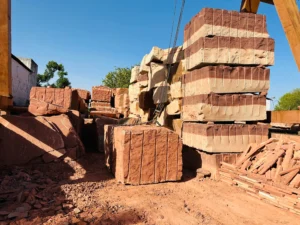How strong is red sandstone in india
Red sandstone, particularly from India, is a prominent building material celebrated for its durability and aesthetic appeal. This article delves into the strength and characteristics of Indian red sandstone, shedding light on why it’s a favored choice in construction and architectural projects.
Historical Significance
Indian red sandstone has a rich history, prominently used in ancient Indian architecture. Notable examples include the majestic forts and palaces of Rajasthan and the UNESCO World Heritage Site, the Red Fort of Delhi. Its widespread use throughout centuries is a testament to its durability and timeless beauty.
Geological Composition
Red sandstone is primarily composed of quartz and feldspar, two of the earth’s most abundant minerals. This composition contributes to its strength and resistance to weathering. The distinct red color comes from iron oxide (rust) present in the stone, giving it not only a unique color but also an added layer of protection against environmental factors.
Physical Properties
The strength of red sandstone is measured in terms of its compressive strength and durability. Indian red sandstone exhibits excellent compressive strength, making it suitable for heavy structural applications. This strength is complemented by its ability to withstand harsh weather conditions, including extreme temperatures and heavy rainfall.
Applications in Construction
Owing to its strength and aesthetic appeal, red sandstone is widely used in construction. It’s preferred for load-bearing walls, foundations, and as a decorative element in buildings. Its ability to be carved and shaped also makes it popular in intricate architectural designs, sculptures, and landscaping projects.
Comparison with Other Building Materials
When compared to other natural stones like granite or marble, red sandstone stands out for its balance of durability and workability. It’s easier to carve than granite and more weather-resistant than marble, making it a versatile choice for various architectural styles.
Sustainability and Environmental Impact
The extraction and processing of red sandstone have evolved to become more environmentally friendly. Modern quarrying techniques aim to reduce the ecological footprint, and the stone’s longevity contributes to sustainable construction practices.
Maintenance and Longevity
Red sandstone requires minimal maintenance, primarily regular cleaning to prevent staining. Its natural resistance to wear and tear means that structures built with red sandstone can last for centuries, as evidenced by historical buildings that stand tall to this day.
Conclusion
Indian red sandstone’s blend of strength, aesthetic appeal, and historical significance make it a distinguished choice in the world of construction and architecture. Its enduring qualities, versatility in application, and sustainability factors ensure its continued prominence in both traditional and modern building projects.
By understanding the properties and benefits of Indian red sandstone, architects, builders, and conservationists can continue to utilize this natural resource in a way that respects its cultural heritage while embracing its potential for future projects.

